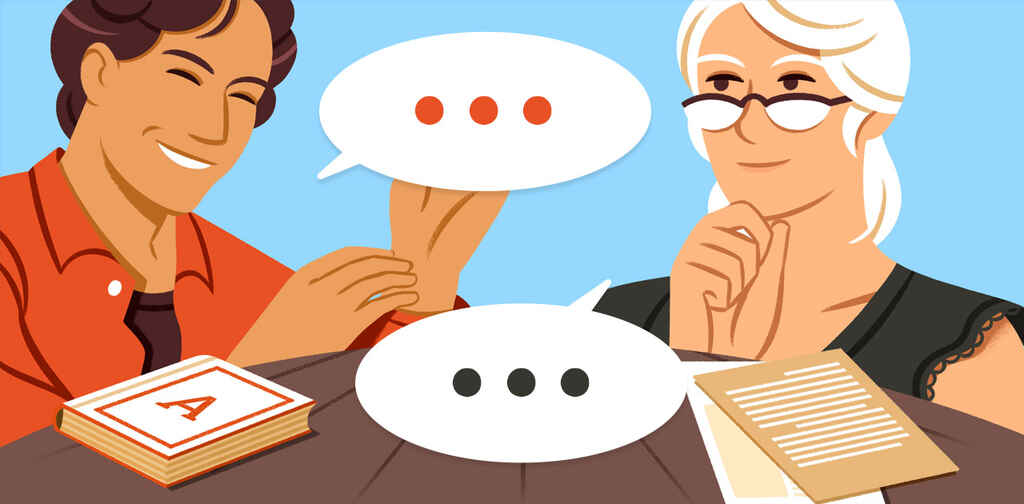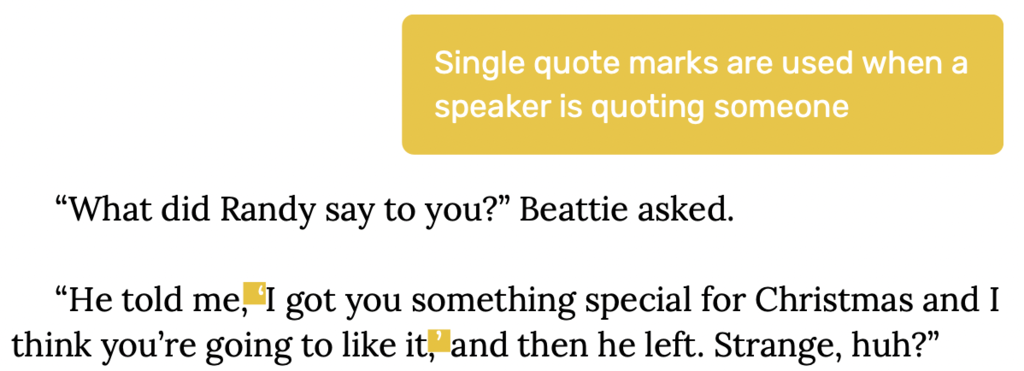Do You Continue on After Indenting Dialogue or Do You Start a New Line
Most readers and writers have been exposed to countless dialogue lines in print, so why does dialogue punctuation elude so many of us?
The answer is that well-written dialogue, like good book design, operates subliminally. The function of good dialogue punctuation is to bring clarity, flow, and tone to a sentence, by virtue of quietly looking just right and beautifully unremarkable. In this post, we'll take you through the basic rules for how to punctuate dialogue correctly. By the end, you can be sure that your dialogue never trips over its own commas ever again.
1. Use double quotation marks (if you're in the US)
In American English, direct speech is normally represented with double quotation marks: "just so."

In British and Commonwealth English, single quotation marks are the standard.
'I say, old bean,' the wicketkeeper said, 'Thomas really hit us for six. Let's pull up stumps and retire to the pavilion for tea and biscuits.'
In this post, we'll be looking at US standards — in particular, the widely accepted standards set by the Chicago Manual of Style. Let's get to it!
2. Put punctuation inside the quote marks (with some exceptions)
Misplaced periods are the most common mistake writers make when punctuating dialogue. When completing a spoken sentence, you should always have the period inside the quote.
"It's time to pay the piper."
You might see British editors occasionally place a period (or full stop, as they say) outside the quote marks. In those cases, the period is not used for spoken dialogue but for quoting sentence fragments, or perhaps when styling the title of a short story like 'The Gift of the Magi'.
But what about other types of punctuation?
The most common way to indicate speech is to write dialogue in quotation marks and attribute it to a speaker with dialogue tags, such as he said,she said or Margaret replied or chirped Hiroko. This is what we call "attribution" when you're punctuating dialogue.

FREE RESOURCE
Get our Dialogue Tag Cheatsheet
Upgrade your dialogue with our list of 270 alternatives to "said."
When the speaker is attributed after the dialogue, you insert a comma inside the quotation marks.
"Come closer so I can see you," said the old man.
If the speaker is attributed before the dialogue, there is a comma outside the quotation marks.
Aleela whimpered, "I don't want to. I'm scared."
If the utterance (to use a fancy linguistics term for dialogue 🤓) ends in a question mark or exclamation point, they would also be placed inside the quotation marks.

3. Start a new paragraph every time the speaker changes
This is one of the most fundamental rules of organizing dialogue. To make it easier for readers to follow what's happening, start a new paragraph every time the speaker changes, even if you're using dialogue tags.
"What do you think you're doing?" asked the policeman.
"Oh, nothing, officer. Just looking for my hat," I replied.
The new paragraph doesn't always have to start with direct quotes. Whenever the focus moves from one speaker to the other, that's when change lines. Here's an alternative:
"What do you think you're doing?" asked the policeman.
I scrambled for an answer. "Oh, nothing, officer. Just looking for my hat."
💡Pro tip: Imagine you're watching the conversation play out in front of you in real life. Every time you feel like you would turn your head and look at a different character, either because they've started to speak, or you're anticipating their reply, that's when you would start a new paragraph.

FREE COURSE
How to Write Believable Dialogue
Master the art of dialogue in 10 five-minute lessons.
Sometimes, writers choose to interrupt a speaker's line with a dialogue tag before allowing them to continue. If the dialogue tag comes between sentences, cap it off with a period. After the tag, resume the quote with the next sentence (beginning with a capital letter).
"I'm not opposed to change," said Colin. "If Uncle Simon wants to cook chicken for Thanksgiving, I really don't care."
However, if the dialogue tag comes partway through a sentence, then it will be followed by a comma. There is no need to capitalize the first letter of the next quote, as you're resuming the previous spoken sentence.
"Whenever mother goes to Paris," Tetsuo smirked, "she always stops at Ladurée on the Champs Elysées for a dozen macarons."
This kind of mid-sentence dialogue tag placement can imply a natural pause in speech, so you can use them to control pacing in your writing.
The primary purpose of a dialogue tag is to let readers know who is speaking. Sometimes, this can be achieved without using a traditional "he said"/"she said" tag at all. Instead, you can break up a line of dialogue with an action beat, which is just a short description of what the speaker is doing while talking. In these cases, the punctuation inside the quotation marks should follow conventional rules.

6. Don't use end quotes between paragraphs of speech
In all the examples above, each character has said fewer than 10 or 20 words at a time. But if a character speaks more than a few sentences at a time, to deliver a speech for example, you can split their speech into multiple paragraphs. To do this:
- Start each subsequent paragraph with an opening quotation mark; and
- ONLY use a closing quotation mark on the final paragraph.
For example:
"Would you like to hear my plan?" the professor said, lighting his oak pipe with a match. "The first stage involves undermining the dean's credibility: a small student protesst here, a little harassment rumor there. It all starts to add up.
"Stage two involves the board of trustees, with whom I've been ingratiating myself for the past two semesters."
Notice how the first paragraph doesn't end with an end quote? This is to indicate that the same person is speaking in the next paragraph. That said, to avoid having pages and pages of uninterrupted monologue, you can always break up any extended speech with action beats.
Want to see a great example of action beats breaking up a monologue? Check out this example from Sherlock Holmes.
7. Use em-dashes — to interrupt speech
When a speaking character is cut off, either by another person or a sudden event, use one or two em-dashes (alt-shift-dash on your keyboard, or option-shift-dash for Mac users) inside the quotation marks.
"Captain, we only have twenty seconds before—"
A deafening explosion ripped through the ship's hull. It was already too late.
Or
"Ali, please tell me what's going—"
"There's no use talking!" he barked.
You can also overlap dialogue to show one character speaking over another.
Mathieu put his feet up as the lecturer continued. "Current estimates indicate that a human mission will land on Mars within the next decade—"
"Fat chance."
"—with colonization efforts following soon thereafter."
Sometimes, the writer/narrator will want to jump in with some narration in the middle of some dialogue. This might be to insert action or show a character's reaction to what's just been said. In this case, use the em-dash outside the quotation marks.
"In the blink of an eye" — the detective snapped his fingers — "the burglar was gone without a trace."
Or
"The president is dead" — the room fell silent — "and I'm the man who killed him."
8. Trail off with ellipses. . .
Sometimes, people won't finish their sentences, and it's not because they've been interrupted. You can indicate the speaker trailing off with ellipses (. . .) inside the quotation marks.
Velasquez patted each of his pockets. "I swear I had my keys . . ."
Ellipses can also suggest a small pause between two people speaking.
Dawei was in shock. "I can't believe . . ."
"Yeah, me neither," said Lan Lan.
💡Pro tip: The Chicago Manual of Style requires a space between each period of the ellipses. Most word processors will automatically detect the dot-dot-dot and re-style them for you — but if you want to be exact, manually enter the spaces in between the three periods.
9. Use single quotes when your speaker quotes someone
In the course of natural speech, people will often directly quote what other people have said. If this is the case, use single quotation marks within the doubles and follow all other rules of punctuating dialogue as usual.
 But what if a character is quoting another person, who is themselves also quoting another person? In complex cases like this (which thankfully aren't that common), you will alternate double quotation marks with single quotes.
But what if a character is quoting another person, who is themselves also quoting another person? In complex cases like this (which thankfully aren't that common), you will alternate double quotation marks with single quotes.
"I asked Gennadi if he thinks I'm getting the promotion and he said, 'The boss pulled me aside and asked, "Is Sergei going planning to stay on next year?"'"
The punctuation at the end is a double quote mark, followed by a single quote mark, followed by another double quote. It closes off: 1) what the boss said, 2) what Gennadi said, and 3) what Sergei, the speaker said.
Quoting quotes within quotes can get pretty messy, so consider falling back on indirect speech. Simply relate the gist of what someone said:
"I pressed Gennadi on my promotion. He said the boss pulled him aside and asked him if I was going to leave next year."
10. Use italics to indicate thoughts and internal monologue
It's not uncommon for readers to hear exactly what characters are thinking, especially with close third person limited and omniscient narration. There are two ways to approach this. First, with indirect dialogue:
A crumpled '39 Cadillac lay burning at the bottom of Runyon Canyon. Richard knew only one guy in town who drove that model: his brother.
If you want to express the exact words a character is thinking, use italics.
Richard spied the burning Caddy. There's only one guy in town who owns that model, he thought. Jamie.
💡Pro tip: Be careful to italicize the terminal punctuation when styling internal dialogue this way.
Some authors will use quotation marks when writing thoughts, but the most important thing is to maintain consistency (which a copy editor or proofreader should help you with before publication).
Polish your book with a professional
Meet Neil Gaiman's, George R. R. Martin's, and George W. Bush's editors and proofreaders at Reedsy
Learn how Reedsy can help you craft a beautiful book.
Hopefully, these guidelines have clarified a few things about punctuating dialogue. If you want to see these rules in action, you can find some great dialogue examples here.
Source: https://blog.reedsy.com/guide/how-to-write-dialogue/dialogue-rules-punctuation/

0 Response to "Do You Continue on After Indenting Dialogue or Do You Start a New Line"
Post a Comment